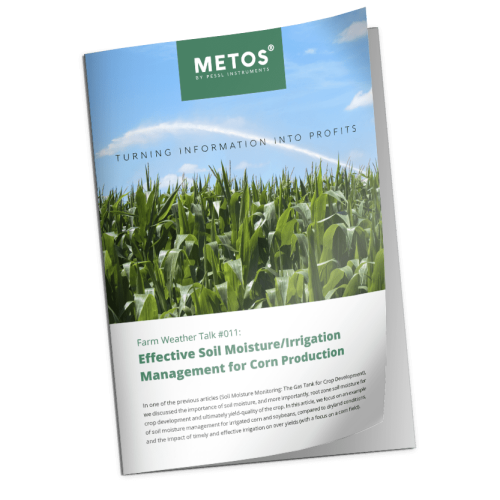Farm weather talk is back! Read about the impact of timely and effective irrigation, with a focus on a corn field.
Effective Soil Moisture / Irrigation Management for CORN PRODUCTION
In one of the previous articles (Soil Moisture Monitoring: The Gas Tank for Crop Development), we discussed the importance of soil moisture, and more importantly, root zone soil moisture for crop development and ultimately the yield-quality of the crop.
In this article, we focus on an example of soil moisture management for irrigated corn and soybeans, compared to dryland conditions, and the impact of timely and effective irrigation, with a focus on a corn field.
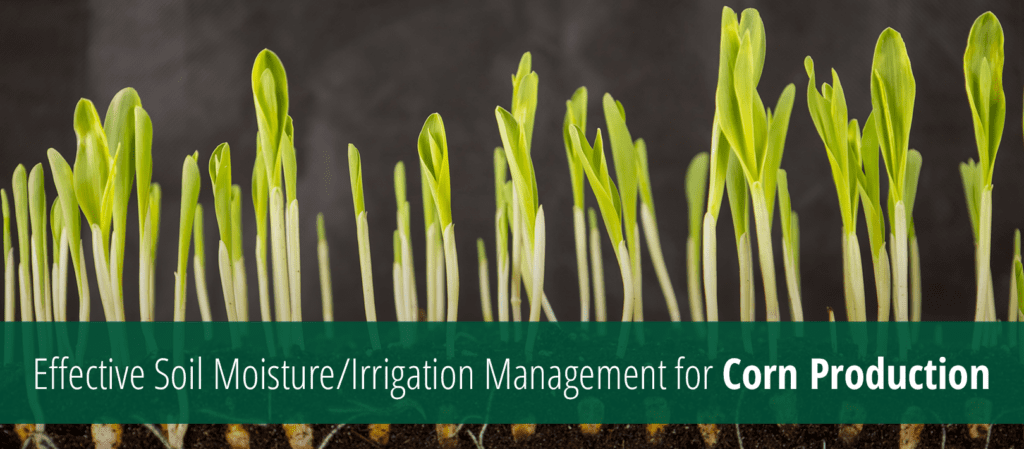
BACKGROUND
Timely and effective irrigation management is critical for maximizing crop yields, especially during the early to mid-reproductive stages of corn and soybeans and with the cost of inputs today. As corn and soybeans enter the early to mid-reproductive stages, irrigation is critical to meet the increasing crop water needs since precipitation and soil moisture can’t meet the crop water demand during this period.
Water or moisture stress results when the crop’s water demand is higher than the supply (precipitation & stored soil moisture) and can result in reduced biological processes, leading to yield and/or quality penalties.
The graphic below illustrates how a corn crop develops in terms of the canopy and roots and how much water is being used daily throughout the growth cycle. What is shown, is that early in development, with little ground cover, the water use per day is under 1/10th inch, but by the time full canopy and reproduction take place, the daily water use can range from 0.2 to 0.35 inches on a warm day. In a week, this is 1.35 – 2.5 inches. The corn crop must meet the water requirement from either stored soil moisture and/or rain irrigation. If the daily or weekly amount is not met, then growth and nutrient updates are reduced, which can lead to yield losses and quality issues.
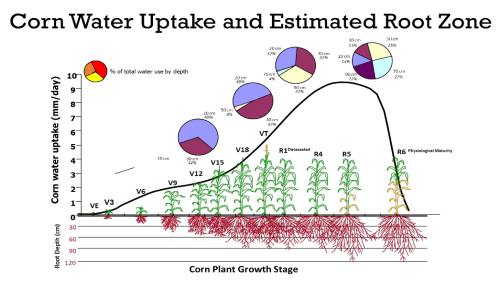
To ensure optimal yields, it’s recommended to maintain soil moisture levels above 50% of the plant’s available water in the root zone (50% between field capacity and wilting point), referred to as the refill point, after the R2 full bloom stage in soybeans and from tasseling through the black layer stage for corn.
The 50% level root zone soil moisture content can be accurately determined using a soil probe or water balance (checkbook). The water balance method can be determined using a fully equipped weather station that measures the necessary parameters, i.e., precipitation, wind speed/direction, solar energy temperature, etc. The forecast conditions can be tracked using the site-specific forecast that is built for the field from the weather station data, forecast models, and AI.
FIELD-LEVEL USE CASE FOR CORN
The graph on the right clearly shows high soil moisture values (VWC > 28-38%) at all depths, throughout the critical phenological stages of tasselling-silking through the black layer (Fig. 1 – In FieldClimate, use the Accumulation Tools to calculate your field-specific growing degree-days, upper and lower thresholds, from your planting date).
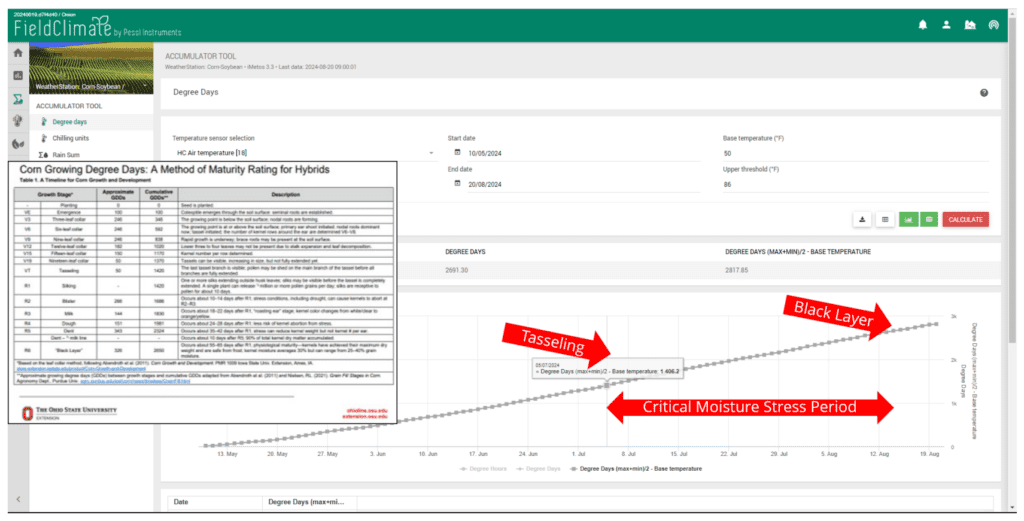
By mid-to-late July, the roots have reached 23 to 28 inches, which is indicated by the stair stepping of lines on the chart (Fig. 2).
It might be a little daunting to understand all the soil moisture lines and values if you are not well-versed in reading soil moisture probes, but with a little understanding of soil properties, you can produce an easy-to-read PAW (Plant Available Water) chart.
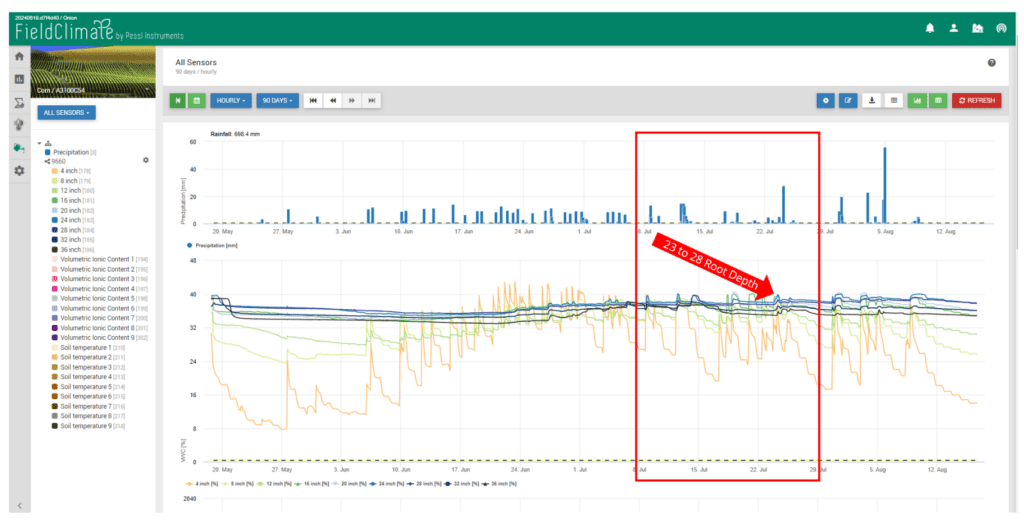
In the example below, we have 9 sensors, every 4 inches for a 3-foot probe, with the Field Capacity (FC) and Refill Point (RFP) defined for each sensor. This can be obtained from standard soil survey data from a local soil test or from reading a long-term soil moisture chart from the probe.
In FieldClimate, you can set the FC and RFP points for each sensor along a probe length by selecting the PAW operation.
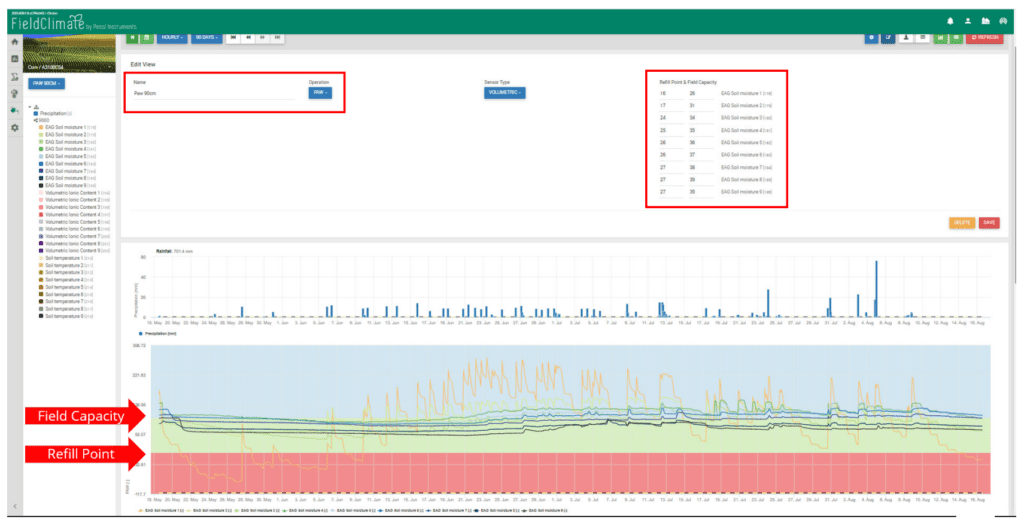
Based on the PAW chart, it’s clear that soil moisture levels for each depth have been kept at high levels throughout the year (especially during the critical stages of tasselling-silking to the black layer stage), which is also evident from the total precipitation and irrigation amounts of 27.5 inches recorded by the field-specific precipitation gauge.
A nearby weather station, which is just measuring precipitation (no irrigated water), has recorded 19 inches through the same period.
Maintaining soil moisture levels at the upper end of PAW values will maximize the yield potential of the crop, given that fertility and crop protection are maintained at a high level. If you’re going to water the crop well, you need to feed the crop with the necessary nutrients and crop protection products as well

IN-FIELD YIELD PREDICTION
We can further look at the impact of timely and effective irrigation on yield by using a field-specific or crop zone-specific Yield Prediction Solution. In previous discussions we have talked about how a yield prediction can be set up for each field or crop zone, which provides a daily estimate of yield to date and physiological maturity based on the two most important environmental factors of water and temperature.
CONCLUSION
- An infield IoT device and probe can be used for timely and effective irrigation management, i.e., management of root zone soil moisture.
- Plant Available Water (PAW) limits (between Field Capacity and Refill Point) can be defined for each sensor depth in the rooting zone.
- An easy-to-use color-coded chart of saturated, ideal (PAW), and water stress ranges can be generated for each probe and field location.
- Soil water maintained at ideal PAW (Plant Available Water) levels is crucial for proper crop physiological development and yields.
- An in- or near-field weather station can be used to generate site-specific, hourly updated, and seasonal weather forecasts, which is part of irrigation management and yield prediction.
- With an in-or-near field weather station and site-specific forecast, a yield prediction to date and physiological maturity can be generated for the current year and long-term normal.
- Considering the cost of each water and fertigation application, maintaining soil moisture levels in the PAW zone is essential for targeting yield: ROI 10>1 for an in-field probe and yield prediction.
Ready to save water, and money?
LET US HELP YOU PICK THE BEST WATER MANAGEMENT SOLUTION FOR YOUR FIELD
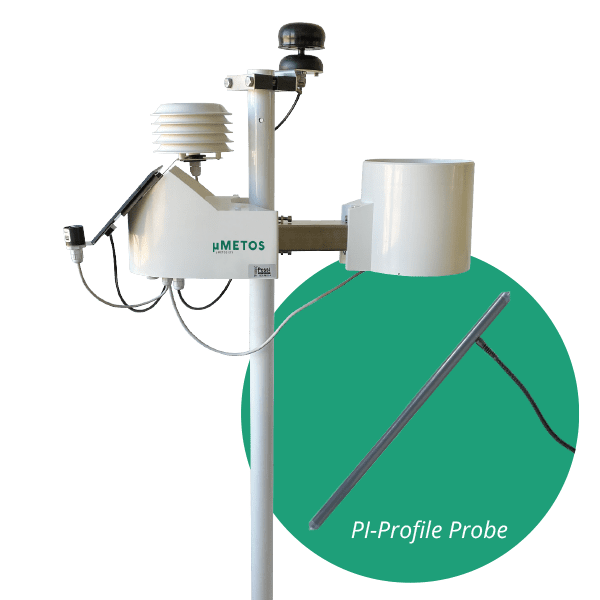
Want to learn more?
Download the brochure for a much more detailed insights, examples, and explanations!
